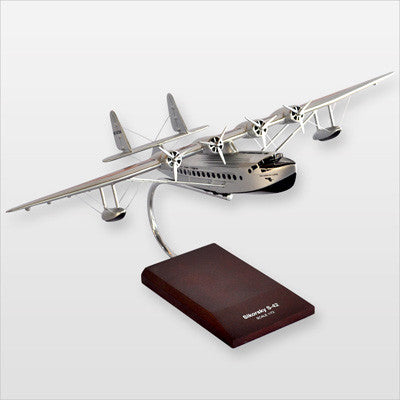Executive Series B-29 "Bockscar" Mahogany Model
$ 212.95
Introducing the ready-to-ship B-29 "Bockscar" mahogany model. This 1/72 scale model was handmade with precision and accuracy to produce the finest model that will be the centerpiece of your collection for years to come. This model is a perfect gift for pilots and aviation enthusiasts alike. Not too big or too small, this model features a wingspan of 23.75 inches and a length of 17 inches. This model features a very accurate paint scheme with realistic panel lines. This collectible B-29 represents the Boeing B-29 Bockscar, one of only two aircraft in history to drop a nuclear weapon in anger. Along with Enola Gay the B-29 that dropped the atomic bomb on Hiroshima Bockscar helped speed the end of World War II. Painstakingly built from Philippine mahogany by our skilled craftsmen with a wealth of detail, this B-29 makes a great pilot gift, or a great present for any aviation enthusiast or history buff.
About this Model:
Your model will be delivered exactly as shown in the photographs with the exact same paint scheme. The stand shown in this photograph may vary or change with the model you receive. If you would like to change this model in any other way, please visit our Custom Model section of our website to commission a customized model to be built.
History of the B-29:
Bockscar, assigned to the 393rd Bombardment Squadron of the 509th Composite Group, was one of 15 B-29s specially modified to carry nuclear weapons. Built under license by the Glenn L. Martin Company at what is now Offut Air Force Base Nebraska.
B-29 number B-29-36-MO 44-27297 was delivered to the Army Air Forces on March 19, 1945 and flown to Wendover, Utah. The aircraft was assigned to Capt. Frederick C. Bock and crew C-13. In Wendover, Col. Paul Tibbets, commander of the 509th Composite Group, had gathered top pilots, crews and maintenance personnel to train for a top-secret mission. Under tight security, crews learned to drop a single bomb before pulling away in a 155-degree diving turn. The crews were not told about the nature of their mission and questions were not welcome. It was no accident that the most advanced weapon of the war was to be carried by the most advanced aircraft. The Boeing B-29 was also the most complex aircraft of the Second World War. It dwarfed other bombers, including its famous predecessor, the B-17 Flying Fortress. At 99 feet long, with a wing span of 141 feet, a B-29 weighed more than 120,000 pounds loaded. Its four Wright R-3350 engines could propel it to a maximum speed of more than 350 mph, and to altitudes topping 30,000 feet. The B-29 also featured pressurized crew compartments, a central fire control station directing 10 .50-caliber machine guns in remote-controlled turrets, analog fire control computers, and use of lightweight alloys throughout the aircraft.
Because of its complexity, the B-29 was troublesome to develop engine fires were a particular problem. By 1945, most of the bugs in the Superfortresses were worked out and the huge silver bombers began operations against Japan. High-altitude winds caused problems with bombing accuracy, and Gen. Curtis Lemay then commander of the Air Force began using the B-29 on low-altitude night firebombing raids. The destructive raids which included such aircraft as Lucky Leven helped set the stage for Japans surrender. By July 1945, the 509th was on Tinian Island, making practice drops, instrument calibration tests and 12 practice missions to Japan, dropping conventional explosive versions of the plutonium bomb shape. Bockscar was used on 13 training missions from Tinian, and also flew three combat missions to Japan, dropping the pumpkin nuclear training bombs.
In early August, two nuclear weapons were ready for use and the first mission was set for Aug. 6, 1945. Three days after Enola Gay destroyed Hiroshima, it was Bockscars turn. Although Bockscar was assigned to Frederick Bock, Bocks crew would trade places with the crew of The Great Artiste, a B-29 set up with instrumentation to monitor the nuclear blast. Maj. Charles Sweeney, the usual pilot of The Great Artiste, had flown Bockscar in practice missions in days leading up to Aug. 9, so the crews swapped aircraft to avoid the complex process of making Bockscar a monitoring station.
Taking off from Tinian on the morning of Aug. 9, Bockscar set out for Kokura, the primary target. Off the coast of Japan, Sweeney orbited for 40 minutes while waiting for a third B-29, Big Stink. Finally, Sweeney set off for his target. Kokura was covered in clouds and the crew under orders to bomb visually headed for the secondary target, Nagasaki. Nagasaki was also covered in clouds, and Bockscar was running low on fuel. Sweeney conferred with the weaponeer, Navy Cmdr. Frederick Ashworth, and the two decided to drop the bomb using a radar approach. At the last minute, a break in the clouds allowed the bombardier, Capt. Kermit Beahan, to drop visually. The Fat Man plutonium bomb detonated at just after 11 a.m. 1,540 over Nagasaki, about 2 miles from the planned aiming point. Foothills protected much of the city from the direct blast, but up to 70,000 people died in the attack. Running critically short of fuel, Bockcar landed in Okinawa, finally returning to Tinian 20 hours after it departed on its nuclear mission. Today, Bockscar is on display in the Airpower Gallery at the National Museum of the United States Air Force in Dayton, Ohio.












Share this item: